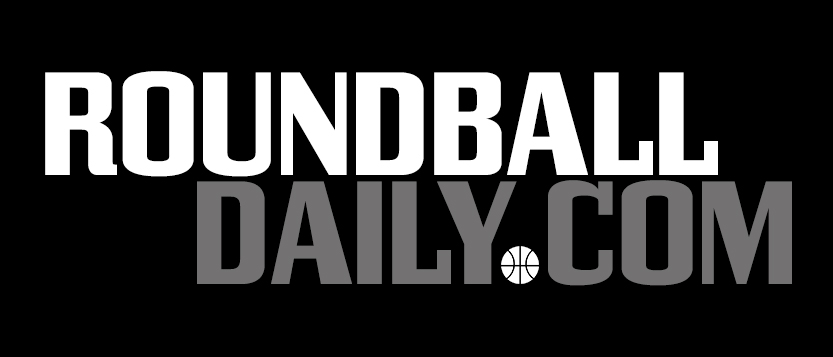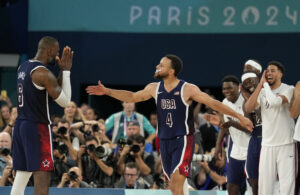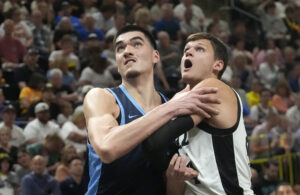- Attacking style not the only reason some Tottenham fans will back Ange Postecoglou until the bitter endPosted 5 months ago
- Paris Olympics takeaways: What did Team USA’s crunch-time lineup say about NBA’s hierarchy?Posted 10 months ago
- Zach Edey posted an easy double-double in Summer League debut. Here’s why he’ll succeed in NBAPosted 12 months ago
- What will we most remember these champion Boston Celtics for?Posted 12 months ago
- After long, seven-year road filled with excruciating losses, Celtics’ coast to NBA title felt ‘surreal’Posted 12 months ago
- South Florida men’s basketball is on an unbelievable heater– but also still on the bubblePosted 1 year ago
- Kobe Bufkin is balling out for Atlanta Hawks’ G League team. When will he be called up to NBA?Posted 1 year ago
- Former Knicks guards Immanuel Quickley, RJ Barrett may yet prove Raptors won the OG Anunoby tradePosted 1 year ago
- Rebounding savant Oscar Tshiebwe finally gets NBA chance he’s deserved for yearsPosted 2 years ago
- Is Tyrese Maxey vs. Tyrese Haliburton the next great NBA guard rivalry?Posted 2 years ago
Fields of mud and little grass are now a thing of the past at the Yale Bowl
- Updated: September 2, 2019
By Joel Alderman
It may have been a portent of things to come, but when the long awaited first game was played in the Yale Bowl well over 100 years ago, the field conditions were far from ideal. What was then the largest sports stadium in the country had (and and still has) a playing surface below sea level and about a mile from a small river, both of which characteristics still exist.
The original gridiron featured natural grass, at least the portions that weren’t torn up by the athletes. The new season of 2019 will soon begin on an artificial FieldTurf surface on top of a mat intended to reduce the possibilities of concussions. It should be noted, however, that Wikipedia states that studies of the safety of FieldTurf are conflicting.
The project is said to have cost about 3-million dollars, not borne by Yale but through contributions from a group of football alumni.
Inklings of a switch
Shortly before the 2015 season, it was reported in the Hartford Courant that artificial turf would be installed. Almost immediately environmentalists and others voiced opposition because the infill for synthetic turf usually includes ground up tires, and can contain up to 20 suspected carcinogens. By December of that year, the Yale Daily News reported that the plan was no longer under consideration.
But four years later it was revived. Late last year, the New Haven City Plan Commission gave the go-ahead and this spring and summer the work was done, with little fanfare and almost in secret.
The crumb rubber infill is made from EPDM, a synthetic material fortified with carbon black. Opponents of the project, and there are many, are left only to hope that their health hazard fears will not eventually prove correct.
Without commenting on the wisdom or lack thereof of the decision to move forward, it affords us a reason to bring up just a few of the Yale Bowl highlight games in which the rain-soaked natural grass and the mud from the exposed dirt played a major role.
The dedication game in 1914
Yale supplied the bowl, but Harvard brought the punch, was how at least one news report described the Harvard victory.
The field had an inch of snow the Friday morning prior to the game. It turned to rain before noon. The New York Times said the precipitation left the field filled with slush by nightfall. Yale had worked out the day before on its old field. But it was “in a pouring rain which drenched the players to the skin.”
By the next morning when the Bowl opened its gates, cold but clear weather took over.
Though the air was good for football, the field was not.
To help assure a suitable surface, a thick covering of hay was spread on the young (six week) grass each night for a week. However, its newness did not allow it to assume the desired compactness.
After the rain had stopped on Friday, the plan was for a heavy roller to be run over the grass. A dry but cool wind would help make the field playable.
In recognition of the good chance of a soft, heavy gridiron, it was observed that such a condition would affect Yale more than Harvard. Yale’s lighter team needed a dry, hard footing for its double and triple passing while Harvard, with its plunging plays, would find it easier to wear Yale down on a heavy gridiron. It was no contest.
Beetles threaten to destroy the field in 1929
A serious crisis to the Bowl’s field was averted just prior to the 1929 season.
The Asiatic beetles were an increasing cause of trouble on golf courses in the country that summer, but the Yale Bowl’s gridiron was the first college football field to be invaded by them and they were discovered eating the roots of the grass. They had already damaged lawns in New Haven’s Westville section, near the Bowl. For those fortunate not to have any direct knowledge of grubs, they are the larvae of beetles. These white C-shaped grubs feast on organic matter in the soil, including grass roots.
Upon discovering them in the Bowl in early October the Connecticut Agricultural Experiment Station was called upon. For four years prior the CAES had maintained quarantine on the beetle. Several thousand pounds of arsenic of lead were applied to the infected area, and officials felt that would keep the infestation from spreading, which it did.
If the beetles had not been controlled by Oct. 27th, one of the all time great games in the Bowl might not have happened – at least not in that venue. But the classic Army-Yale game took place as scheduled and the Bulldogs defeated Army 2l-13 before 80,000 fans. Albie Booth scored all of Yale’s points on three touchdowns and three drop kick conversions, after the Cadets had taken a 13-0 lead.
Army lost in the Bowl, and so did the beetles.
The playing conditions gave Ducky Pond his nickname in 1924
The worst of the natural field was exposed on Nov. 22, 1924, when Yale defeated Harvard, 19-6, in a driving rain on a field that the Times said was “ankle deep in slime” causing the players to be “covered from head to foot with clinging mud.” They were compared to “strange antediluvian mammals wading in a field of mud.”
It was the game in which Yale’s Raymond Pond got his nickname of Ducky for being able to navigate through the mud and slime. Those conditions were probably not matched until the NFL game of 1974 (see below).
Jimmy Wood in the Times Union of Brooklyn, NY, wrote with “the rain slanting down in sheets” Pond went “puddle jumping”
Babe Ruth almost stuck it out in 1932
Many other games have been played under deplorable weather conditions in the Yale Bowl, including the Harvard-Yale matchup on Nov. 19, 1932, when a “day-long rain turned parched grass into pools of mud,” wrote Neil Amdur in The New York Times. He reported that “50,000 persons waded through mud and took a soaking to the skin. . .”
Among them was baseball’s great Babe Ruth, an acknowledged Yale fan who was there with his wife. They stuck it out until the fourth quarter when he was just “another bedraggled figure heading for the exits.”
Paul Gallico in the NY Daily News wrote that “the game was played under desperate conditions” as a series of cloudbursts in gray waves “drenched the spectators and sometimes completely hid the players on the field far below behind curtains of descending water.” He compared the field to a skating rink.
“A mud-splattered, hard-hitting Yale football team” was the opening of the United Press International account of the game.
Time Magazine reported that a “gusty south wind from Long Island Sound lashed rain into the Yale Bowl by the cloudful.”
Perhaps the weather had a mesmerizing effect. Time wrote that when the game ended “Yale men, apparently bewildered by rain, wind, mud and the excitement of seeing their team win (only) its second game this year, rushed down and tore up their own goalposts.”
Since it was the last time the Bowl was used that year, the field survived after a full off-season to regenerate.
New York Jets star compared it to a cow pasture
Just days from its 50th anniversary, Yale Bowl was the scene of the first ever meeting between the two New York pro teams- the Giants and the Jets. Never mind that it was a pre-season exhibition played in high humidity and 86 degree heat. The Jets, fresh off their stunning Super Bowl upset earlier that year (1969), were out to claim the football championship of New York City, even though that city was 70 miles away.
Led by quarterback Joe Willie Namath (with 14-16 pass completions) they were a dedicated lot, and ground the Giants into the ground and parched, patchy grass.
The Jets overcame the conditions and accomplished a 37-14 victory that they proclaimed was just as big as having won the earlier Super Bowl.
But one of them, future Hall of Famer Don Maynard, had the gumption to call out the Yale Bowl field in uncomplimentary terms. He was a Jets tri-captain that day and represented the players at the post-game press conference in the basement of the Ray Tompkins Field House.
Not maliciously, but as part of a generalized answer, Maynard said it was like playing in a “cow pasture.” But he did not let his opinion of the field stand in the way of a challenge issued afterwards.
“If they want to line up again I’ll go back out there right now,” he said in his Texas drawl. Yes, he was ready to do it again, even on the Yale Bowl field he had just described in such an uncomplimentary way.
Good-bye Allie rang out
It was hardly past mid-summer, and despite the eyes and ears of New York that were to follow the game, the field was not as clean or well kept as it should have been. Maybe a dry summer and even those grubs of the past had something to do with it. But for the sellout 70,874 in attendance, divided between supporters of each team, the torn up grass and exposed bare spots meant little. What did matter was that the Jets thoroughly dominated the Giants, whose fans resorted to the “Good-by Allie” song.
A few weeks later Coach Allie Sherman was let go.
The ultimate havoc when grass became mud in 1974
The worst of playing conditions, with a sea of mud and torrents of rain, marked the last of pro football in the Yale Bowl. It took place during the National Football League game on Dec. 8, 1974. The Philadelphia Eagles defeated the New York Giants, 20-7, ending the second and final season the Giants called the historic landmark their temporary home. The new Giants Stadium in New Jersey was under construction and their temporary home at Yankee Stadium was being renovated.
Over the almost two regular seasons in New Haven they only won one time in 1973 and not all in ’74.
Bill Newell in the Hartford Courant observed that “it was the kind of a day when, to the contrary, you couldn’t tell the players even WITH a scorecard. It rained. Oh, how it rained – all the time. As early as the second period, the middle of the Yale Bowl was just one big mud pile.”
Craig Morton, the Giant’s quarterback, said “I have never played in worse conditions.”
New York coach Bill Arnsparger could only recall a game in junior high school that was worse. Winning coach Mike McCormack, a former all-pro defensive tackle, said it was “as bad a weather condition as I’ve even seen.”
United Press International noted that “With no letup in the rain, the field turned into a virtual quagmire in the second half.”
It was pointed out by Neil Amdur in The New York Times, “The day-long rain turned parched grass into pools of mud.”
George Wadley, in the local New Haven Journal Courier, saw the torrential rain “more suitable for growing cucumbers then playing football,” and wrote that the elements were giving a “marvelous imitation of a monsoon.”
December 8th is still the latest date that there has been a game played in the Yale Bowl. Whatever grass that had still been on the playing field after a full schedule of Yale and Giants games was all but washed away that day in 1974.
The Giants then left the Yale Bowl for good, leaving divots and piles of mud in the wake.
Again, Yale at least had the good fortune to have an off-season to develop a new grass field. But the field was never ideal and problems of keeping it in shape continued to exist.
Summation
For better or worse, there will be no more such incidents as hay on the field, an infestation of grubs, puddles of water, thick mud making the players unrecognizable, torrents of rain driving a baseball hero to an early exit, a pro star comparing the field to a cow pasture, or leaving the gridiron in utter destruction.
The Yale Bowl was declared a National Historic Landmark in 1987 for its role in football history. The playing surface is still 27 feet below ground level and just 14 feet above the level of the nearby West River. Only now there is a gridiron of artificial turf. Controversy will continue over the decision to do away with natural grass, and the mud and bare spots that went with it. But, at least some of the aesthetic problems encountered in the first 104 years will not have to be faced again.




